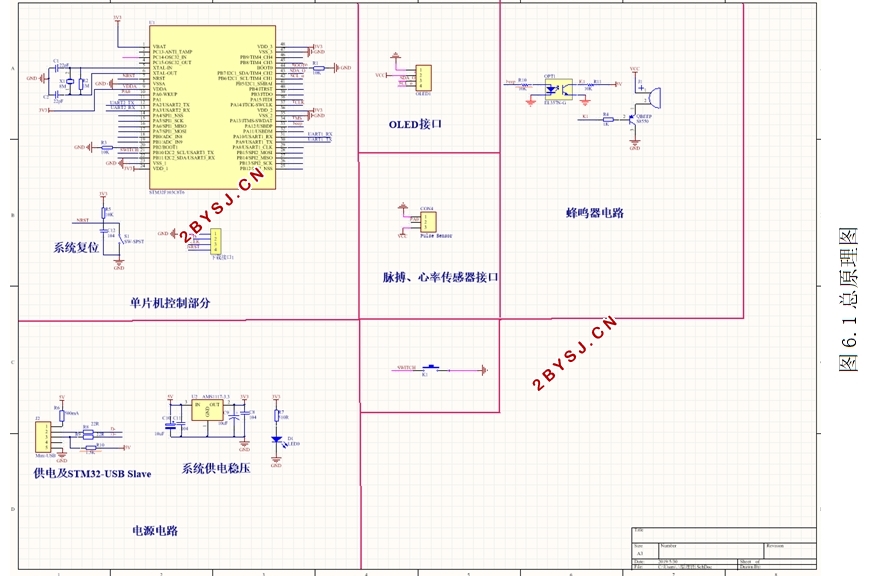心脏信号监测与采集系统设计
无需注册登录,支付后按照提示操作即可获取该资料.
心脏信号监测与采集系统设计(任务书,开题报告,论文9200字)
摘要
医疗保健领域需要通过获取患者的生理信息来完成对患者健康状况的分析,心脏信号就是患者生理信息的重要组成部分,目前心脏信号的获取主要在医院完成,心脏信号的获取仪器往往价格昂贵,体积大,需要专业操作,不适合在家庭,社区服务等场景使用,本课题研究了一种便携式心脏信号监测与采集系统,是对解决上述问题的一次尝试。
本课题是通过STM32微处理器结合各个模块来完成对心脏信号的监测和采集,本次设计包含单片机部分,传感器部分,显示部分,蜂鸣器部分,以及电源部分。采用STM32F103微处理器为控制核心,利用传感器模块来获取心脏信号,利用蜂鸣器完成对一次心脏跳动的提示,并通过OLED12864显示器将心脏的跳动频率和心电图显示出来,本设计体积较小,便于携带,成本较低,可被应用与家庭健康检测,社区健康检测等场景,且工作稳定不易受到影响。
关键词:STM32;心脏信号;心率;光电传感器;OLED
Design of Heart signal Monitoring and acquisition system
ABSTRACT
The field of medical and health care needs to obtain the physiological information of patients to complete the analysis of patients' health status, cardiac signal is an important part of patients' physiological information. At present, the acquisition of cardiac signal is mainly completed in hospitals. The acquisition instrument of cardiac signal is often expensive, large in volume, needs professional operation, and is not suitable for use in family, community service and other scenarios. In this paper, a portable heart signal monitoring and acquisition system is studied, which is an attempt to solve the above problems.
This paper is to complete the monitoring and acquisition of heart signal through STM32 microprocessor combined with each module. This design includes single-chip microcomputer part, sensor part, display part, buzzer part and power supply part. The STM32F103 microprocessor is used as the control core, the sensor module is used to obtain the heart signal, the buzzer is used to display the primary heart beat, and the beating frequency and electrocardiogram of the heart are displayed by OLED12864 display. The design is small, easy to carry, low cost, can be used in family health testing, community health testing and other scenes, and And the working stability is not easy to be affected.
Keywords: STM32; heart signal; heart rate; photoelectric sensor; OLED


目录
摘要 I
ABSTRACT II
第一章 绪论 1
1.1课题背景及其意义 1
1.2国内外发展现状 1
1.3论文结构安排 2
1.4本章小结 2
第二章 方案的论证与选择 3
2.1总体设计 3
2.2心脏信号获取方案的选择 3
2.3传感器的选择 4
2.4单片机的选择 6
2.5本章小结 6
第三章 硬件设计 7
3.1总体硬件设计框图 7
3.2 STM32处理模块 7
3.2.1 STM32接口介绍 7
3.2.2 STM32单片机最小系统 9
3.2.3 复位电路 9
3.2.4晶振电路 10
3.3.3 BOOT0与BOOT1 11
3.4电源供电模块 11
3.5传感器模块 12
3.6 OLED显示模块 13
3.7蜂鸣器模块 14
3.8本章小结 14
第四章 软件设计 15
4.1主函数流程 15
4.2 ADC转换程序流程图 16
4.3心率采集与处理函数 17
4.3 心电图波形处理函数 18
4.4 OLED显示函数编写流程 19
4.5显示切换函数 20
4.6本章小节 20
第五章 调试以及设计结果 21
5.1调试 21
5.1.1硬件调试 21
5.1.2软件调试 22
5.2设计结果 22
5.2.1心率显示 22
5.2.2心电图显示 23
5.3 本章小结 23
参考文献 24
附录 26
致谢 27
